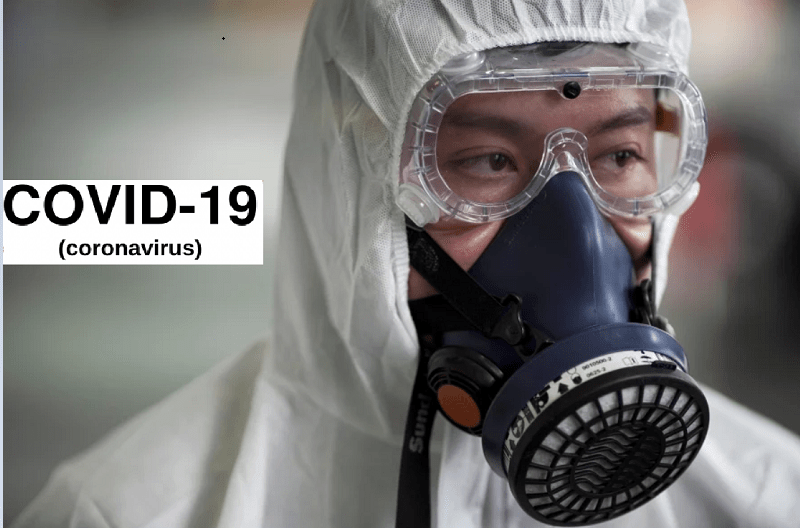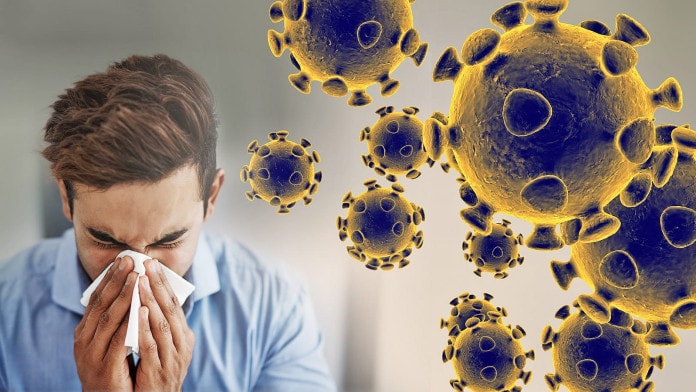
COVID-19 ( Coronavirus): A CoronaVirus is a group of infections that cause respiratory diseases. The new kind of coronavirus found on December 31, 2019, after cases enlisted in China. It causes an illness called coronavirus (COVID-19). The first CoronaVirus (COVID-19) able to infect humans were isolated in 1937. However, it was only in 1965 that the virus got its description as being similar to a crown, then receiving the name coronavirus.
Initially, it was thought that the transmission of the disease happened from animals to people, but with the latest events in China, we know that transmission can also occur from individual to individual

Coronavirus is easily transmitted and can spread in the following ways:
- Contact with contaminated objects or surfaces, followed by contact with the mouth, nose or eyes
- Close personal contact, such as touch or handshake;
- Cough
- Sneeze
- Contact with respiratory secretions
- Anyone who approaches one meter from an infected person is at risk of being infected with the infection
Symptoms of the disease include:
- Fever
- Sneezing
- Cough
- Coryza
- Shortness of breath
Info that is helpful in protecting against coronavirus
10 – Home quarantine instead of a hospital
Among the many safety measures recommended by the World Health Organization, one of them is quarantine. It is suited for patients in good condition, who don’t really need hospitalization.
When a patient is in the hospital, many more people are at risk, as the virus spread easily. People with already low immunity that are in the hospital for other reasons can get infected.
The contrary is also true, as the person which suffering from the new disease can be affected by other diseases that circulate in the hospital.
Quarantine at home is good not only for the reasons just said, but it is also a way of preventing the hospital from becoming overloaded.
People in the home quarantine should take extra care with hygiene, such as wearing a mask when they have direct contact with others, washing their hands frequently, using alcohol gel, and as much as possible not sharing personal items – as glasses and towels.
9 – Beware of fake news
There is a lot of fake news being spread about the coronavirus and how to prevent it, some of them are:
- Taking an overdose of vitamin D prevents coronavirus
- Fennel tea kills the virus
- Garlic, ginger and other herbal remedies as a means of prevention
- Having caught flu protects against coronavirus
- The coronavirus is similar to the AIDS virus
- The new virus can be treated with medicines for HIV, influenza or antibiotics
- Carrying camphor bags keeps the coronavirus away
- Washing your nose frequently avoids coronavirus
- Buying goods from China is dangerous
- Ozone therapy to treat coronavirus
So far, there is no medication, substance, infusion, essential oil, vitamin, specific food, or vaccine that can prevent or treat the contamination with the new virus. This goes for all fake news involving hot tea, vitamin C, vitamin D, and alcohol, among others.
The most reliable information in this regard is that published in medical journals, which has been proven through research. Sites like The Lancet and the Journal of the American Medical Association have collected much of what has come out in terms of medical research on coronavirus.
8 – Children might contract the virus without getting sick
Children are known to be the main transmitters of viruses like influenza. Their immune system is immature not only to elicit an inflammatory response but to contain the virus, so they usually excrete viral units for longer. For example, an adult secretes the flu virus for seven days on average, a child for 14 days, and more.
Other than that, they become more infected, because they live together in the school, share objects, take toys to their mouths and so on. They are an important part of the chain of transmission of viral diseases, since most of those infected have no symptoms, but can pass the virus to other age groups.
Chinese researchers report that the most common symptoms in children are coughing, nasal congestion, diarrhea, and headache. Less than half have a fever, most have no symptoms, and when they do, they recover within a week or two.
But the fact that a child has these symptoms should not be a cause for panic. For now, only people who have these signs and have any relationship with countries with cases of local transmission should be tested and concerned, that is, who traveled there or got in any form of contact with someone who traveled and became ill. And it is worth saying that it is not recommended testing in people without symptoms.
7 – Hand Sanitizer
Alcohol gel, made from ethanol, is an antiseptic – that is, it has the function of disinfecting human skin. However, the term disinfectant generally refers to products used on inanimate surfaces (such as a table, for example).
The word “sterilize” refers to a process that destroys all forms of microbial life, made in specialized equipment and even more potent substances, with objects such as surgical instruments.
The disinfectant action of alcohol is agreed upon by scientists. It acts on the cell wall of the infectious agent, disrupting the proteins or lipids that line it. This process is able to eliminate more than 99% of infectious agents. And the new coronavirus is no exception.
It works best when there is no visible dirt on the skin. “Organic waste harms its action”, comments Sampaio. One more reason to wash your hands often. It is also important not to touch your fingers to the mouthpiece, check the validity of the product, and whether there is a certified chemist responsible for its manufacture – mandatory information on the label.
A Tip: when the product is opaque, it is a sign that it has lost its active ingredient. Then it will no longer be effective.
6 – Differences Between Flu and CoronaVirus
Above it was already said that the main symptoms of COVID-19 are fever, cough, and difficulty for breathing. Lots of patients show even more symptoms, such as sore throat and runny nose. The issue here is that a person with common flu also presents the same picture. To be clear, only by watching these symptoms it is impossible to distinguish between coronavirus or the virus of flu.
At the moment, one thing that helps in the diagnosis is the information about the last travels an individual with these symptoms made. If the individual visited an area where there is an intense transmission of the virus around two weeks before the symptoms appeared, then the risk of coronavirus can’t be discarded right away. Also if the person had any contact with people who are infected or are under suspicion, care must be taken. If none of this is the case, the probability of the common flu is more plausible.
Even that said, if a person returns from a place that has many cases of the virus, only this information isn’t sufficient to know for a fact that the person is infected. All of this is only helpful to filter possible infections and not to make people scared. But in case someone is sick and fits the above descriptions, he or she should go to a hospital and get tested for the virus.
5 – Don’t travel to places where there are many people infected
The United States Center for Disease Control (CDC) recommends that trips to China and other highly affected countries be made only in situations of extreme need.
If it is impossible to postpone a trip to China, follow personal hygiene measures, and avoid large crowds. Also, prefer cooked food and don’t share cutlery.
Oh, and remember not to rub your eyes, nose, and mouth or come into contact with sick animals.
As already said for elderly people, another advice is to keep the vaccination record up to date, even if there is no immunization for the new virus. This is because, together with the coronavirus, other viruses and bacteria would cause additional damage.
A Chinese study, published in The Lancet, investigated the symptoms and groups most vulnerable to this disease and showed that most of the severe conditions are due to the low immunity of patients.
In other words: the coronavirus is more dangerous for those with weak immune systems, which can occur due to the action of other infections, as well as the flu, which has a vaccine for it.
4 – Elderly People.
Why are elderly people more susceptible to coronavirus? An important reason is immunosenescence. It is a natural process of aging, which decreases the capacity of the immune system. As a result, the incidence of infectious diseases in the elderly generally increases. That goes for the coronavirus, the flu and so on.
There are straightforward and effective measures:
• Take great care of your health
• Stay hydrated
• Remember about washing your hands very often
• Don’t get touch with people who were in areas infected with the virus
Another key measure is to make sure you are vaccinated against the most common diseases. This is not to say that there is already a vaccine able to prevent the infection. In fact, if you protect yourself from other infections, you keep your immunity high enough to prevent against this new enemy. Besides, vaccination lowers the risk of befuddling the coronavirus with influenza, which causes flu, for example.
In addition, it is known that the death rate of the disease is very low when compared to SARS and MERS.
While all of that is true, it is important to consider that it is a virus with significant contagion capacity, so everyone needs effective preventive measures. Elderly people can quickly become weak in the face of an infection.
3 – What to do in workplaces
Equipment such as chairs, tables, telephones, keyboards, and computers have to get a nice clean with the use of cloth and disinfectant regularly as COVID-19 is transmissible through surfaces, this actually being one of the main forms of contamination.
If an outbreak ever occurs, if possible, bosses should send their workers home with home office instructions, as this helps to avoid unnecessary contact. Beyond that, employees who use public transport are more vulnerable to the virus, so staying at home is safer.
Making disposable handkerchiefs available in different spots in the workplace is also very important, if not a must. Employees need to be able to blow their noses or cough without spreading virus droplets. Needless to say, all bins must be lidded and next to the points where handkerchiefs are placed.
In the case someone is sick or with a fever and respiratory symptoms, the recommendations are to not go to work. Officers should understand this is a situation of risk.
It is not the best option, but in the case a handkerchief is not available, covering your mouth and nose with your forearm when coughing and sneezing is a solution. And of course, your arm needs to be washed right after.
Alcohol gel dispensers are one more thing companies should place in the workspace. These are really helpful, and we will discuss them more deeply later.
Not only making the items listed above available is important, but letting employees know they need to use them is a big part of the prevention. Hanging some posters promoting handwashing is one more good measure to keep everyone safe and aware.
2 – The USE of masks
You have probably seen images of people on the streets of China with masks on their faces in news reports. And yes: it can slightly reduce the risk of infection. However, the accessory is only recommended in local situations of a severe outbreak. This is the only scenario in which the mask is indicated for the general population.
Especially because, when not used correctly, it only gives a false sense of security. In addition, it is of little use to wear this equipment and not wash your hands. The mask is more suitable for those who have a respiratory infection not to spread it.
1 – What was the origin of the outbreak?
The most likely hypothesis, as per the World Health Organization (WHO), is that the epidemic started in a market in the Chinese city of Wuhan and was transmitted from a live animal to a human host, before spreading from human to human.
In this market, both live and butchered creatures were sold. But still, it is not certain which animal is responsible for the new coronavirus.
But it is also uncertain whether the outbreak really started on the Chinese market. A study by Chinese researchers published in the medical journal Lancet claims that the first diagnosis of COVID-19 occurred much earlier, on December 1, and that the patient in question “had no contact” with this Wuhan market.
Uncovering this origin is “detective work,” says Professor Andrew Cunningham of the Zoological Society of London in the UK.
A wide variety of animals may have served as the “host” of the virus, especially the bat, which is known to carry a considerable number of different coronaviruses.
According to Fernando Spilki, president of the Brazilian Society of Virology, this is one more virus that infects the humankind because of its environmental impact.
By deforesting, destroying the environment, and making wild animals closer to us for food, recreation or pets, humankind encounters viruses with which we had no contact, and then we have no immunity against them. We get exposed to what is called a new virosphere.






